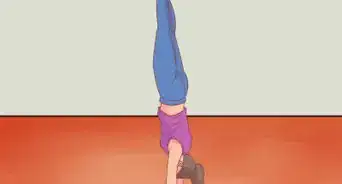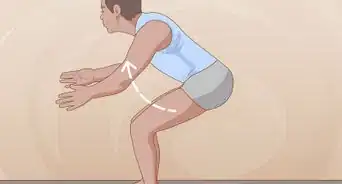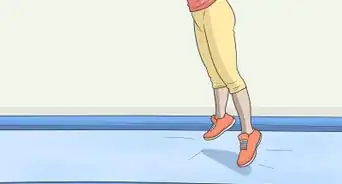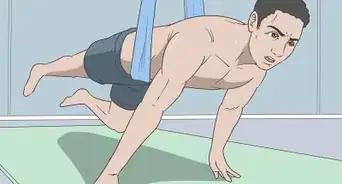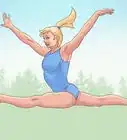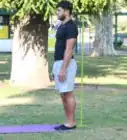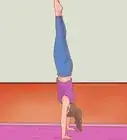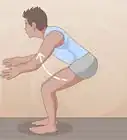This article was co-authored by Greg Maurer. Greg Maurer is a Health & Fitness Specialist and the Vice President of Fitness and Education for Workout Anytime. With over a decade of experience, he specializes in functional training, yoga, pilates, exercise and aging, home exercise programs, and numerous fitness diets. Greg holds a BS in Exercise Physiology from Temple University.
There are 10 references cited in this article, which can be found at the bottom of the page.
wikiHow marks an article as reader-approved once it receives enough positive feedback. This article has 34 testimonials from our readers, earning it our reader-approved status.
This article has been viewed 342,594 times.
Gymnastics is a fun, impressive sport that lets you build strength, flexibility, and confidence! Whether you look up to Simone Biles, Aly Raisman, or Brody Malone, you might be wondering how to build up your gymnastics skills at home. The good news is, you can work on your skills and build up your strength in between lessons. Check out these drills below!
Steps
Doing the Spider-man Against the Wall
-
1Crouch down. Put your hands spread out on the ground. Face away from a nearby wall. Make sure an adult is present when doing this move to keep you from falling.
-
2Walk up the wall backwards. Put your feet against the bottom of the wall and "walk" backwards. Keep your hands on the ground. Straighten your elbows and knees as you go up.Advertisement
-
3Move closer to the wall using your hands. Once your legs are straight and your toes are up against the wall, it's time for your hands to do the walking. Start by moving your right hand back slightly. Bring your left hand back to line up with the right. Repeat this until your stomach is very close to or flat against the wall. You have just done an easy handstand.
-
4Return to position safely. In gymnastics, when a coach or guide tells you to "return to position," you should go back to the stance you started at. In this case, return to the crouch from Step 1. To get back down, walk forward with your hands and let your legs slowly slide down the wall.
Jumping
-
1Stand up straight. Make sure your feet are together with your toes pointed forward. Raise your arms straight up into the air above your head.
- The straight jump is a fairly basic jump that is safe to do at home. It will help you to strengthen your legs, improve your cardiovascular endurance, and learn to keep your balance.
- While you are unlikely to hurt yourself doing this jump, you could still potentially twist your ankle or fall.
-
2Begin your jump by bending your knees. While you squat, simultaneously swing your arms back behind you. Make sure your arms are as far back as they can go while you reach the lowest part of your squat. Don't go so far down as to lose your balance, but spread your arms to the side if you need to.
-
3Spring up into the air. Push off of your feet and extend your legs. You will return to your original position with straight legs and upper body, but now you will be airborne. As you pop upward like a spring, swing your arms back up over your head for added momentum.[1]
-
4Stick the landing. Gymnasts coined this phrase to describe a method of landing on their feet that absorbs the shock and prevents injuries. To do this, land with your legs apart and knees slightly bent. Hold your arms out for balance. In a perfectly stuck landing, your feet should not move at all.[2]
Doing the Splits
-
1Stand with your feet far apart at either side. This is also called the "straddle position." They should be much further apart than your shoulders. Try to make your legs as wide as you can go while comfortably standing with your legs straight.
-
2Inch your legs further outward. Allow your feet to slide further apart. Until you are well-practice, take this step slowly. Keep your legs straight. Stop immediately if you feel any sort of pain. Forcing a stretch can cause injury.
- Feel free to ask a trusted friend or relative for help, too. While you're in the split position, ask them to very gently and lightly press down on your shoulders with their index fingers.[3]
-
3Hold your splits. Once you've gone down as far as you can, hold that position for as long as you can. Maintaining this stretch will help improve flexibility and strength. Use your hands for support if you feel wobbly.
- Try to hold your splits for around 3 to 5 minutes per area.[4]
-
4Practice your splits until you are able to reach the ground. Unless you are already athletic, you will probably not be able to do the splits on your first try. As you build up strength and flexibility, you will be able to stretch your legs further apart and get closer to the ground. This may take you a while, so try your best to be patient.
Learning the Forward Roll
-
1
-
2Start your roll. Straighten your legs to push forward onto your back. Keep your head tucked in. It should never touch the ground. Make sure to keep your spine bent and your legs tucked together. Use your arms for support and added momentum.[7]
-
3Sit up. While you're on your back, bend your knees back together and hold your shins. Roll forward with the momentum generated by your legs. You should end flat on your feet in an upright squatting position. Do this and Step 2 all in one fluid motion to successfully complete a forward roll.[8]
-
4Stand back up. An experienced gymnast should be able to do this without pushing off from the floor with his or her hands. However, until you've practiced enough, it's perfectly fine if you need your hands. If you feel unbalanced at all, don't hesitate to use your arms for support.
Practicing Your Scales
-
1Stand on one foot. Keep your planted leg straight, along with your upper body.
- The purpose of scales is to learn how to stably balance your body. In order to be a skilled gymnast, you need complete control of your muscles at all times. Scales allows you to practice this skill in a safe environment.
-
2Raise one leg slowly in front of you. Hold your arms apart for balance. Keep your toes pointed forward and both legs and torso straight. Once your leg is in position, hold it in place for a few seconds.
-
3Switch legs after each scale. You will want to strengthen and learn how to balance both sides of your body equally.
- Bring your foot up higher and repeat your scales after doing them with both legs. With training, you will eventually be able to keep your balance with your leg facing forward at a right angle to your body.
-
4Do a back-leg skill using the same methods. Swing one leg backwards, keeping both your legs straight. Tilt your body forward to maintain a straight line between your body and airborne leg.
- With practice, you will be able to do a back leg scale so far that your body and leg become parallel with the ground.[9]
Getting Ready
-
1Tell an adult that you want to train at home. Ask a parent or guardian before starting any sort of gymnastics training in the house. Your guardian should be home and available to react immediately in case you are injured. Ideally, an adult should be in the same room with you to act as a spotter.
-
2Wear appropriate clothing. You will need to make sure your garments are not baggy enough that they impede your movements but also not so tight that they cause chafing. Make sure you are comfortable in the clothes.
- If you are a girl, the best thing you can wear for gymnastics is a leotard.
- Singlets are another specialty sports garment and can be worn by gymnasts of any gender. Like the leotard, you may also choose to wear athletic shorts over top of your singlet.
- You can also wear a T-shirt or tank top with athletic shorts instead. Make sure that your clothes are free of buttons, zippers, or snaps.
- Do not wear socks. Exercising barefoot will prevent slips and falls.
- If your hair is long, tie it back securely.
- Only wear glasses if they are especially made for sports and won't slip. If not, leave them in a safe place where they won't get damaged.
-
3Set up a safe area to train in. You will need a large area free from clutter. Preparing a room for gymnastics will help you to avoid serious injury.
- Only practice on a soft surface. Do not practice on bare hardwood, tile, or laminate flooring. You can also ask an adult to buy a home athletic mat.
- Ask an adult to move all furniture against the wall. Make sure that the furniture is free of sharp corners. If necessary, cover sharp edges with a pillow or thick comforter.
-
4Consider at-home exercise equipment. Pull-up bars are relatively inexpensive and easy for an adult to install. There are also athletic bars and balance beams you or an adult may buy for your home. However, these take up a lot of space and are best left for a dedicated exercise room.
-
5Warm up. To get the most out of your training, you will need to get warmed up properly.[10] Warming up will boost your performance and prevent muscle soreness.
- Start by stretching your whole body. Tilt your head slowly from side to side, and gently roll your head backwards. Stretch your arms by holding each across your chest for a few seconds and then raising it back over and behind your head. Do a few lunges to stretch your legs and lower back. Lift each leg slightly off the ground and roll each ankle. Flex each of your toes. Roll your wrists and flex your fingers.
- After stretching, get your heart rate up with a quick aerobic exercise. This can be any kind of simple high-intensity workout you can do on your own in a small space. Examples of these include jumping rope, running in place, or doing jumping jacks. Do this for a few minutes until you can feel your heart beating quickly but not for so long that you start to feel winded.
-
6Check your equipment. Make sure the floor, mat, or rug you'll be exercising on is flat and free of bumps. If you're using a balance beam, get comfortable on it first. Make sure that it doesn't wobble before standing up on it. If you're using bars, try shaking them to make sure they're stable before you put any weight on them.
Expert Q&A
-
QuestionHow long does it take to learn a front flip?
 Tanya BerensonTanya Berenson is a Gymnastics Instructor and the General Manager of the Los Angeles School of Gymnastics. With over 25 years of professional gymnastics experience, Tanya has also served as a consultant to USA Gymnastics, has served as the USA World Maccabi Games Head Coach, USA Gymnastics Meet Director, and RAS counselor. She holds a B.Ed. in Early Childhood Development from the University of California, Los Angeles.
Tanya BerensonTanya Berenson is a Gymnastics Instructor and the General Manager of the Los Angeles School of Gymnastics. With over 25 years of professional gymnastics experience, Tanya has also served as a consultant to USA Gymnastics, has served as the USA World Maccabi Games Head Coach, USA Gymnastics Meet Director, and RAS counselor. She holds a B.Ed. in Early Childhood Development from the University of California, Los Angeles.
Gymnastics Instructor You can probably learn how to do a front flip within 6 to 8 weeks. Front flips are so much more natural for us because we can see what's in front of us, and the motion isn't as challenging or scary.
You can probably learn how to do a front flip within 6 to 8 weeks. Front flips are so much more natural for us because we can see what's in front of us, and the motion isn't as challenging or scary. -
QuestionHow do people get so flexible?
 Community AnswerBy practicing a lot. The more you practice, the more flexible you will become. And the earlier you start, the better.
Community AnswerBy practicing a lot. The more you practice, the more flexible you will become. And the earlier you start, the better. -
QuestionHow can I learn to do a back walkover?
 Community AnswerPractice bridges first. Then, try to lift your legs, one at a time, over your head.
Community AnswerPractice bridges first. Then, try to lift your legs, one at a time, over your head.
Warnings
- If you look at emergency room visits, one of the sports at the top of the list for girls is gymnastics. Many injuries are preventable however. [13]⧼thumbs_response⧽
References
- ↑ http://gymnasticswod.com/content/straight-jump
- ↑ http://www.physicaleducationupdate.com/public/Gymnastics_Teach_Them_to_Stick_a_Landing_Using_a_Hula_Hoop.cfm
- ↑ Tanya Berenson. Gymnastics Instructor. Expert Interview. 22 May 2020.
- ↑ Tanya Berenson. Gymnastics Instructor. Expert Interview. 22 May 2020.
- ↑ http://www.flashmavi.com/gymnastics_floor_front_roll_how_to_do_a_frontroll
- ↑ http://www.drillsandskills.com/skills/Floor
- ↑ http://www.flashmavi.com/gymnastics_floor_front_roll_how_to_do_a_frontroll
- ↑ http://www.flashmavi.com/gymnastics_floor_front_roll_how_to_do_a_frontroll
- ↑ http://greatist.com/fitness/beginner-guide-advanced-bodyweight-skills
- ↑ Greg Maurer. Health & Fitness Specialist. Expert Interview. 13 August 2021.
- ↑ http://www.researchgate.net/publication/7102180_Does_warming_up_prevent_injury_in_sportThe_evidence_from_randomised_controlled_trials_Journal_of_Science_and_Medicine_in_Sport_9(3)_214-220
- ↑ http://www.fitbodyhq.com/fitness/how-to-do-the-splits
- ↑ http://www.momsteam.com/team-of-experts/gymnastics-safety-many-injuries-are-preventable
About This Article
You don’t need to go to a gym to do gymnastics. There are a few simple moves you can do at home. Just make sure you’re in an open space with no furniture you could knock into. To do scales, stand on one leg with your arms out at your sides, then raise your other leg in front of you. Hold the position for a few seconds, then switch legs. If you have enough floor-space, practice your forward rolls. Start in a squat with your hands on the floor, then tuck your head in and roll over your shoulders. You can also practice doing the splits by standing with your feet apart and slowly sliding your legs out as far as you can go. For more tips, including how to practice aerobic jumps at home, read on!
-Step-7-Version-4.webp)
-Step-8-Version-4.webp)
-Step-9-Version-4.webp)
-Step-10-Version-4.webp)
-Step-11-Version-4.webp)
-Step-12.webp)
-Step-13.webp)
-Step-14.webp)
-Step-15.webp)
-Step-16.webp)

-Step-17.webp)
-Step-18.webp)
-Step-19.webp)
-Step-20.webp)
-Step-21.webp)
-Step-22.webp)
-Step-23.webp)
-Step-24.webp)
-Step-25.webp)
-Step-26.webp)
-Step-1-Version-4.webp)
-Step-2-Version-4.webp)
-Step-3-Version-4.webp)
-Step-4-Version-4.webp)
-Step-5-Version-4.webp)

-Step-6-Version-4.webp)

